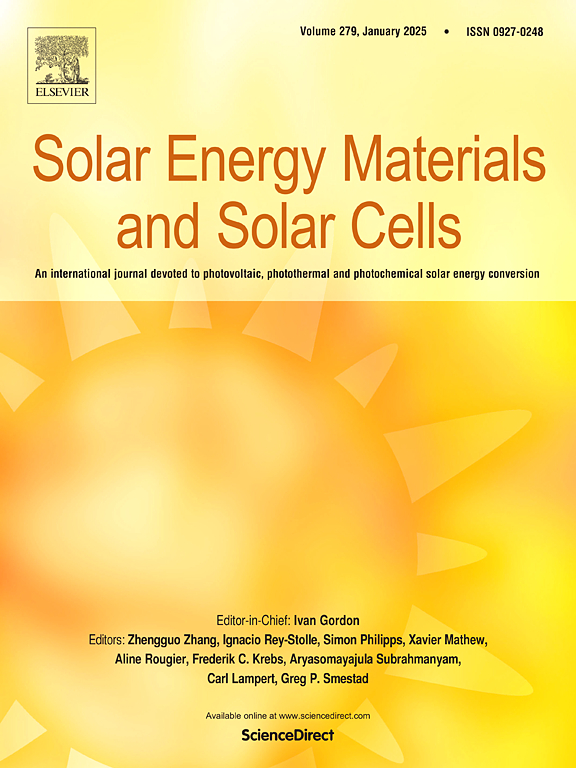Analysis of solar thermal collector with S-shaped ribs via energy, exergy, economic, and environmental (4E) approaches
IF 6.3
2区 材料科学
Q2 ENERGY & FUELS
引用次数: 0
Abstract
The current research examined the energy, exergy, economic, and environmental performance of a solar thermal collector (STC) featuring S-shape type ribs (SSTR) on its absorber plate. The proposed design aims to enhance energy utilization through optimized roughness parameters, minimizing pressure losses while maximizing heat transfer efficiency. The analytical model used in the study evaluates the exergetic efficiency () and its dependency on design variables. In the experiments, SSTR were mounted on absorber plates with parameters relative roughness height ranging from 0.022 to 0.054, relative rib pitch () ranging from 4 to 16, relative roughness width () ranging from 1 to 4, and arc angle ( ranging from 30° to 75°. The best for the system is obtained for Reynolds number () between 2500 and 7500. The highest of 1.87 % for SSTR-STC is achieved for of 6000 at = 0.043, = 8, = 3, = 60°, and the temperature rise parameter ( of 0.0122 . These findings confirm the technical and financial viability of using SSTR-based solar collectors for sustainable industrial and agricultural applications. Economic analysis reveals a favorable cost-effectiveness with an estimated energy cost of 0.12 $/kWh and a 20-years operational life with $116.47 annual cost establishing financial viability. This study performed an enviro-economic assessment to calculate the CO2 reduction advantages of current assessed STC. The yearly useful energy ( of STC with SSTR was calculated as 957.76 compared with conventional STC of 600.91 The environmental assessment highlights significant CO2 reduction benefits, with an annual mitigation potential of approximately 38.31 tonnes and associated carbon credit savings of $555.49/year. The findings are crucial for renewable energy solutions, energy efficiency, carbon footprint reduction, and sustainable industrial and agricultural uses.
从能源、能源、经济和环境(4E)的角度分析s形肋太阳能集热器
目前的研究考察了太阳能集热器(STC)在吸收板上具有s形肋(SSTR)的能源、能源、经济和环境性能。提出的设计旨在通过优化粗糙度参数来提高能量利用率,最大限度地减少压力损失,同时最大化传热效率。研究中使用的分析模型评估了火用效率(ηEXGY)及其对设计变量的依赖关系。实验中,SSTR安装在相对粗糙度高度(eRIB/DHY)为0.022 ~ 0.054、相对肋距(PRIB/eRIB)为4 ~ 16、相对粗糙度宽度(WD/wSR)为1 ~ 4、弧角(αARC)为30°~ 75°的吸收板上。当雷诺数Re在2500 ~ 7500之间时,体系的ηEXGY最佳。在eRIB/DHY = 0.043, PRIB/eRIB = 8, WD/wSR = 3, αARC = 60°,温升参数(ΔT/ISR)为0.0122 Km2/W时,sr - stc的最大ηEXGY为1.87%。这些发现证实了在可持续的工业和农业应用中使用基于sstr的太阳能集热器的技术和财务可行性。经济分析显示了良好的成本效益,估计能源成本为0.12美元/千瓦时,20年的运行寿命,每年成本为116.47美元,建立了财务可行性。本研究进行了一项环境经济评估,以计算当前评估的STC的二氧化碳减排优势。与传统STC的600.91 kwh/yr相比,SSTR STC的年有用能(Enout)计算为957.76 kwh/yr。环境评估强调了显著的二氧化碳减排效益,每年的减排潜力约为38.31吨,相关的碳信用额每年可节省555.49美元。这些发现对于可再生能源解决方案、能源效率、减少碳足迹以及可持续的工业和农业利用至关重要。
本文章由计算机程序翻译,如有差异,请以英文原文为准。
求助全文
约1分钟内获得全文
求助全文
来源期刊

Solar Energy Materials and Solar Cells
工程技术-材料科学:综合
CiteScore
12.60
自引率
11.60%
发文量
513
审稿时长
47 days
期刊介绍:
Solar Energy Materials & Solar Cells is intended as a vehicle for the dissemination of research results on materials science and technology related to photovoltaic, photothermal and photoelectrochemical solar energy conversion. Materials science is taken in the broadest possible sense and encompasses physics, chemistry, optics, materials fabrication and analysis for all types of materials.
 求助内容:
求助内容: 应助结果提醒方式:
应助结果提醒方式:


